 Image search results - "akita" Image search results - "akita" |

One of the Big Three Festivals in Tohoku, the Kanto Matsuri has men in happi coats balancing tall paper lantern-bedecked bamboo poles, called kanto, on their foreheads, shoulders, hand palms, or hips. Held on Aug. 3 to 6 near JR Akita Station.A kanto is carried to the festival site before nightfall.
|
|
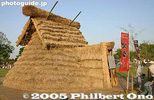
Festival's focal pointThis grass hut is at the center of the festival site which is within the Sakitama Tumuli Park. It will be burned later in the evening for the festival's climax.
|
|

The festival is held along a straight, 800-meter section of San'o Odori Road, a 20-min. walk from Akita Station.In the evening, the main event starts at 6:38 p.m. with a taiko drum-beating performance or minyo dancers on San'o Odori Road. At 7:17 p.m., some 200 kanto are carried into the street to the sound of flutes and taiko drums. At 7:40 p.m. following a brief address by the city's mayor, the performance begins as the kanto are raised all at once.
|
|

Offerings
|
|
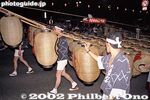
A kanto is carried into the street to the sound of flutes and taiko drums.
|
|

Festival siteIt is a circular site with people sitting along the perimeter.
|
|
|

SpectatorsThese people are sitting in the best area to view the festival.
|
|

The largest kanto is 12 meters high, weighs 50 kilograms, and has 46 paper lanterns. The smaller kanto are 5 and 7 meters high. The kanto symbolizes a ripe rice plant with unhusked golden grains (the paper lanterns). The festival is therefore a prayer for a good harvest.
|
|

EntertainmentAn outdoor stage provides a variety of entertainment during the day.
|
|
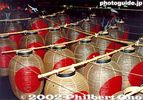
During the festival period, several events are held in the daytime. One is the "Kanto Challenge Corner" where the first 100 applicants on each day can try balancing the smaller kanto. Each participant receives a "Kanto Master" certificate. There is also the Kanto Myogi (Stunt) Contest where group and individual participants compete to be the year's best kanto technician.
|
|

Festival participantsThey are dressed in the costume of the ancient Kofun (Tumuli) Period of Japan. They will be carrying torches from the nearby tumuli.
|
|

Balancing act. The kanto symbolize rice plants ready to be harvested.This is perhaps the most anxiety-provoking festival. Men in happi coats balance these tall paper lantern-bedecked bamboo poles, called kanto, on their foreheads, shoulders, hand palms, or hips. While watching, you can't help thinking, "Will it fall?" or worse, "Will it fall on me?" The candle-lit paper lanterns contrasted nicely against the dark sky.
|
|

TumulusCherry trees are at the top.
|
|

The objective is to balance the kanto steady enough so that the candles in the paper lanterns don't go out. The performer has to move about deftly whenever there is a gust of wind or when the pole starts to bend over. After attaining a steady balance, the skillful technician shifts the pole to other parts of his body while his surrounding colleagues clap and shout "Dokkoisho! Dokkoisho!"
Occasionally, someone loses his balance and the pole and lanterns come crashing down on the power lines, safety ropes, or right on the crowd. When I was there, one came crashing down on the crowd I was in. We all screamed. But it was surprisingly harmless. All the lanterns flamed out and some lanterns had holes. The lanterns were just relit and raised again. Falling kanto added real drama.
|
|

Shinto ceremonyAt around 6:30 pm, the festival climax starts.
|
|

The tallest kanto is 8 meters high. It is made higher by connecting bamboo pole extensions at the bottom. The more skillful men added more pole extensions than usual or fanned themselves with a fan while balancing the kanto. At halftime, everyone took down the kanto and they moved out. Another group of kanto masters came in and the spectacle restarted.
|
|

Torch bearers enter
|
|

Notice the little pad on his forehead where he will balance the pole next.It takes years to master kanto stunts. The best performers started training during childhood. From the beginning of July, you can see people practicing on Akita's uncrowded streets. Fathers teach their children as the rest of the family watch. Although today's kanto masters hail from various occupations, in the past, the kanto performers were mostly perfectionist artisans. The kanto is based on this artisan spirit. A kanto has to be constructed perfectly. Otherwise, it is remade all over again.
|
|

Marvelous spectacle
|
|

The kanto's paper lanterns and the performers' happi coats are emblazoned with the crest of the respective city block.Thirty-seven city blocks were represented. There were also corporate logos on some lanterns.
|
|

Parade aroundThe torch bearers parade around the entire perimeter before they gather around the hut.
|
|
|
|

Taking it to the limits.This guy is balancing a super-high kanto while the pole arches to an extreme degree. During the final moments, he ran across the road to maintain the balance long enough for the pole to snap under the weight of the lanterns. That was really neat. In the right photo, a crashed kanto is readied for another balancing attempt.
|
|

Male prince
|
|

Notice the kanto in the background caught in the power lines.The kanto performance has also been introduced overseas. The first overseas performance was held in San Diego, California in 1976 as part of America's bicentennial celebration. Since then, kanto performances have been well-received in Australia, Hawaii, China, Italy, Germany, France, Brazil, and England.
|
|

Female princess reigning over the Sakitama Fire Festival in Gyoda, SaitamaShe's 15 years old.
|
|

Crash
|
|
|

A broken paper lantern is disposed of.At 8:40 p.m., the main performance stopped and the spectators were invited to try their hand at the kanto for 10 minutes. At 8:50 p.m., all the kanto were withdrawn from the site.
|
|

Torch lightingThe prince and princess light the torch that will ignite the hut.
|
|

Climax
|
|
|
|

Torch bearers from the tumulus
|
|
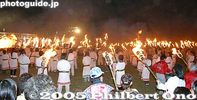
Stage ceremonyThe torch bearers gathered in front of the stage where there were speeches and cheers.
|
|

FireworksThe festival ended at 7:30 pm.
|
|

JR Akita Station
|
|

Kubota Castle
|
|

Inside Kubota Castle
|
|

Akita bijin (beauties) promoting Akita rice
|
|

Park mapThe park has numerous tumuli as well as an archeological museum.
|
|

Inariyama TumulusPeople are allowed to climb up the tumulus.
|
|

Inariyama Tumulus
|
|

Maruhaka-yama TumulusThis is Japan's largest round tumulus (also used during the Fire Festival).
|
|

Maruhaka-yama TumulusCherry trees are at the top.
|
|
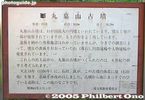
Maruhaka-yama Tumulus sign
|
|

Shogun-yama Tumulus
|
|

Kawarazuka Tumulus
|
|

Futagoyama Tumulus
|
|
|
|
|